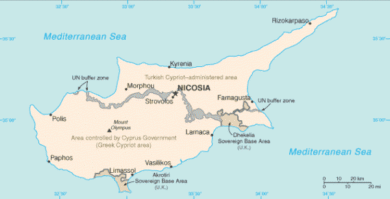| Republic of Cyprus Kypriaki Dimokratia (Greek), Kibris Çumhuriyeti
(Turkish)

Location an island in
the Mediterranean Sea, just south of Turkey

Area 3,572 sq mi
(9,251 sq km)
Greatest Distance E-W 128 mi (206 km)
Greatest Distance N-S 75 mi (121 km)
Highest Point Mount Olympus; 6,403 ft
(1,952 m)
Lowest Point Mediterranean coast; sea
level
Natural Resources copper, pyrites,
asbestos, gypsum, timber, salt, marble, clay earth
pigment
Nationality Cypriot
Population (July 2013 est) 1,155,403
Largest Cities Nicosia
Ethnic Groups Greek, Turkish
Religions Greek Orthodox, Muslim
Languages Greek, Turkish, English
Capital Nicosia
(Lefkosia)
Form of Government republic
Present Constitution Adopted August 16,
1960
Chief of State and Head of Government President
Nicos Anastasiades (since February 28, 2013)
Cabinet Council of Ministers appointed jointly
by the President and Vice-President
Legislature unicameral House of Representatives
(Vouli Antiprosopon)
Judiciary Supreme Court
Local Administration 6 districts
Currency Euro (Turkish
New Lira in area administered by Turkish Cypriots)
Per Capita Income $27,100
Industries tourism, food and beverage
processing, cement and gypsum production, ship repair and
refurbishment, textiles, light chemicals, metal products,
wood, paper, stone and clay products
Agricultural Products citrus, vegetables,
barley, grapes, olives, vegetables; poultry, pork, lamb;
dairy, cheese
Export Commodities citrus, potatoes,
pharmaceuticals, cement, clothing, cigarettes
Import Commodities consumer goods,
petroleum and lubricants, intermediate goods, machinery,
transport equipment
Independence from the United
Kingdom Achieved August 16, 1960
National Holiday Independence Day,
October 1
Flag white with a copper-colored
silhouette of the island (the name Cyprus is derived from
the Greek word for copper) above two green crossed olive
branches in the center of the flag; the branches
symbolize the hope for peace and reconciliation between
the Greek and Turkish communities

Questions or comments about this
page?
|
 SKC Films Library
SKC Films Library

